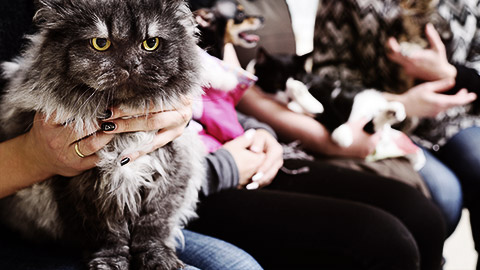Exposure to trauma, adversity or critical incidents involving animals
Psychological trauma, according to the Diagnostic and Statistical Manual of Mental Disorders (DSM), occurs when an individual experiences an event involving death or serious injury and feels “intense fear, helplessness or horror” as a result.
There are many different types of traumas when working in the animal industries.
Trauma examples …
- Euthanasia
- Death
- Animal cruelty
- Palliative care
- Abusive clients
- Getting injured
- Sustaining an injuring inflicted by an animal
Humans are not equipped to process trauma effectively.
Some people have better resources. These resources include:
- Personal support systems
- Inherent resiliency
- Finances for professional help.
The brain is efficient and economical. When you experience a traumatic incident, if you are unable to resolve it due to time or capabilities or access to resources among many other reasons, your brain employs a ‘diversion tactic’. The body senses something is wrong and tries to alert the brain by giving signals. These signals can include:
- Fatigue
- Mood changes
- Weight loss
- High blood pressure
- Exhaustion
- Headaches
When a traumatic event happens, often the brain shuts off or ignores these alerts to protect itself and function well in the moment and shifts attention to current or future issues.
Sometimes if you experience repetitive or unresolved traumatic situations, the stress can build up and you may not notice outward signs for months or years.

Palliative care
Palliative care is an option for owners who have pets with terminal illness or diseases that do not have a cure. The aim of palliative care is to make the animal as comfortable as possible in their last weeks or days of life. This could be in the form of pain medications, dietary strategies, daily cleaning or grooming (basic) or interactions with humans. Being exposed to palliative care treatments or animals can be comforting and difficult to deal with emotionally. Animals that are in palliative care can all look very different. Sometimes an animal can look weak, underweight, have sores or conditions that are not easy on the eye.
It is important to talk to your work colleagues and ask questions to understand the situation or illness. Being aware and understanding why an animal looks the way it does can help you process your feelings and help you handle the animal appropriately.
Euthanasia
Euthanasia is a term used to describe the humane killing of an animal. Euthanasia provides pet owners with the option to a painless and peaceful end to their pet’s life. This decision is often made to end an animals suffering, whether that be from a terminal illness, old age, or a traumatic event.
It is important to note that euthanasia is not only used to end an animals suffering. There are no laws around what animals can and cannot be euthanised. Some pounds and shelters may euthanise animal that they cannot rehome or who medical bill would be too big. Behavioural issues such as aggression are another reason people or shelters may opt to euthanise an animal.
It is important to understand before entering the workplace that healthy animals can be euthanised and this can be extremely difficult to witness. If you are ever uncomfortable, you should speak to your supervisor and remove yourself from the situation.
Exposure to euthanasia and palliative care are one of the bigger risk factors for compassion fatigue. It is important to know the signs of compassion fatigue and to speak up if you think you are struggling. We will discuss compassion fatigue in Topic 3.

Attachment, loss, and grief can all be triggers for stress in the animal care industry. So, what are they?
Attachment
Attachment can be defined as affection, fondness or sympathy for someone or something. This includes animals.
Animals offer a form of acceptable and unconditional love for people. This acceptance and unconditional love can be difficult to find in people and therefore leads to more intense attachment to animals than to other people.
When working in environments such as pounds, rescues or shelters, it can be easy to build attachment to animals, especially if they have been mistreated.
You may also build a sense of attachment to work colleagues or friends you make within the Animal Care industry.
Additional reading
Loss
Loss can be defined as the fact or process of losing something or someone. Through palliative care and euthanasia, you will experience loss working in the animal care industry.
Grief
Grief can be defined as intense sorrow, especially caused by someone’s death. It is a natural response to loss of someone close, including the loss of animals and co-workers or friends who work in the animal care industry.
Feelings involved with grief include intense sadness, shock, numbness, denial and anger.
Grief can be physically and emotionally draining. During periods of grief you can become exhausted and not be able to complete simple tasks or leave the house.
The Five Stages of Grief
There are 5 stages of grief. Everyone experiences grief differently and there is no set order that the stages of grief are experienced. The five stages of grief include:
-
Denial is when you pretend the loss isn’t happening. The denial stage allows you more time to absorb the news and gradually begin to process the loss. Denial is a defense mechanism that aids in numbing the intensity of the situation.
Once you start to move out of the denial stage, you are comforted with a lot of sorrow and the emotions that you didn’t feel throughout the denial stage. This can be a very difficult part of the grieving process.
-
Examples of Denial
Here are some things might say or think in situations where you are in denial:
- “This is a mistake. I haven’t lost my job. They will call tomorrow and explain it is all a misunderstanding.
- “This is just a dream. I will wake up soon and Pop will be sitting in his rocking chair eating cake.”
- “It’s not over. My husband is just upset. He will realise and come home tomorrow.”
-
Anger is a masking mechanism. This stage is when you hide the emotions and/or pain that you are feeling. This stage may not necessarily show its as aggression or outright fury, but rather feelings of bitterness or resentment.
The anger that you feel during this stage may be redirected at the person or object that isn’t to blame. Your feelings are so intense in the moment that you act accordingly by directing this anger at the person who died, family or friends, work colleagues or even inanimate objects.
As animal care workers, you will experience moments of attachment, loss and grief. These factors contribute to stress, and it is important to recognise when you are dealing with attachment, loss or grief and to seek help.
-
Examples of Anger
Here are some things you may say or do whilst experiencing the anger stage:
- “I hate this job anyway. They will regret firing me.”
- Throwing household objects or breaking things out of anger
- Blaming the person, you have lost by saying things like “If he has just stopped smoking” or “If he has just slowed down, this wouldn’t have happened.”
-
During the bargaining stage you look for ways to regain control or change the outcome of a situation. You will begin to bargain with yourself, and use words like ‘what if’ or ‘If only.’ This is done to combat the feelings of vulnerability and helplessness. This stage can postpone feelings of sadness, confusion or hurt.
-
Examples of Bargaining
As mentioned above, bargaining if often in the form of statements that include the words like ‘what if’ or ‘if only.’ This would mean that you might think or say things like:
- “If only I had spent more time with him before he passed.”
- “What if I had seen the doctor sooner? Would I still have this diagnosis?”
- “If only I had called her last night, I could have changed her mind.”
-
The depression stage is full of heavy emotions. These emotions could include:
- heavy sadness
- hostility
- overwhelmed
- hopelessness
- empty
- numb
- You might also have the desire to isolate or go into ‘flight’ mode.
- Loss of hope for the future
- Struggling to get out of bed each day or not getting out of bed at all
- Difficulty concentrating
- Difficulty making decisions
- Struggling to sleep
- Crying often
- Feeling tired
- Lack of motivation
- Overwhelmed by daily tasks
-
Signs that may indicate you or another person are experiencing the depression stage include:
It is important to remember that not everyone processes grief the same. Not everyone will spend the same amount of time in each stage of grief.
Acceptance

There are many stakeholders that you will interact with when working in the animal care industry. These include your work colleagues, the clients or customers and the general public. It is important that you know how to deal with or respond to the behaviour of these stakeholders.
Your workplace should have a policy or procedure on how they would like their employees to deal with the behaviour of clients and members of the public. They should also have clear expectations on how you should behave as an employee. Be sure to read through all the workplace policies and procedures and ask your supervisor if you cannot find any information on how they would like you to deal with or manage the behaviour of clients and members of the public.
Communicating with clients
It is extremely important to maintain clear communication channels with clients, especially when you have their animals in your care. Although, the love of the job comes from working with animals, it still heavily relies on our ability to communicate with humans.
Client conflict often stems from a lack of communication or miscommunication. Always be sure to clearly communicate any procedures, treatments etc as well as the price.
If an animal was to become injured or unwell whilst in your care, you should communicate this with the owners immediately. Remember, this may not be your r esponsibility. Report any signs of illness, injury or abnormal behaviour to your supervisor, who can determine the steps to follow from there.
When communicating with clients or members of the public remember to:
- Be clear and concise.
- Stay calm and confident (especially when client become angry or frustrated).
- Actively listen.
- If you are unsure of an answer to a question, be honest and tell the client you will go find someone who can better assist with their enquiry.
- Use language that they will understand. If specific terminology is required, make sure you explain what it means.
- Be friendly and personable.
It is important build rapport with your clients and/or customers. Building rapport with clients can be achieved by:
- Using open body language. This could include maintaining eye contact, avoid crossing your arms or leaning in slightly when talking.
- Treat them as a person not just as a client. Be friendly, ask them about their pets.
- Try to remember small details from your previous conversation with them. This will show them that you listed and care.
Complaints from clients or members of the public
If a client is unhappy with the services provided or would like to make a complaint, here are some easy steps to follow to stop it from escalating into further conflict:
- Listen
- Understand why they are upset. Ask questions to confirm you understand.
- Apologise. Be genuine.
- If you cannot resolve the issue yourself, communicate this to the client and advise the client that you will go and find your supervisor.
It is important not to take things personally or become defensive. This could lead to further conflict.
Managing expectations
Managing expectations ties in with the previous subtopic. Communicating with clients is key to managing their expectations. If we give clients a timeline of the day or when services will be provided, we need to make sure that we either stick to these timings or communicate with clients when we know there is going to be a delay.
Ethical dilemmas
There are both practical and moral dilemmas that individuals encounter working in the animal care industry. These include:
- Euthanasia
- End of life care
- Economics
- Inadequate provision of care
Ethical dilemmas may arise due to differences in beliefs, whether these are religious or regarding the value of an animal’s life, responsibilities, and duty of care of both clients and veterinary staff as well as deciding what is best for the animal.
It is important that you do not judge clients for decisions made regarding euthanasia or end of life care. You can use communication skills to discuss medical options, explore reasons as to why it is an ethical dilemma or try to reach a solution with clients or even colleagues.
